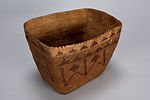Basket
About this object
History of use
Coiled baskets in a range of sizes, embellished with distinctive patterns and motifs of animals and humans, have long been made and used by the Tsilhqot’in people. Spruce roots are usually preferred over cedar roots as the foundation for these strong and functional containers, which are often made in a flared, burden-basket form. Baskets were used extensively for carrying, storage and cooking, in addition to being made for trade or sale.
Specific techniques
This type of basket was usually made of coiled split and bundled spruce-tree roots, stitched together by long, fine strands of spruce root. Beginning at the base of the basket, the weaver would gradually build up the form out of a continuous coil, stitching the upper layer to the coil below. Each stitch splits the one directly below it as the root is drawn through the coil. At the same time, the weaver folds or imbricates strands of grass and bark into each stitch on the outside of the basket, often creating dark patterns on a light background.
Physical description
Coiled basket (parts a-f) with bifurcated stitches; parallel splint base construction; partially imbricated. The design consists of geometric shapes (two per side, one per end); two rows of discrete triangles in red on plain ground; rim is beaded. Parts b-d are square shaped sections of a bended branch that wrapped around the top of the basket. There are two rawhide ties (parts e-f) that used to attach to the outside.
Categories
Materials
Date Made
Before 1900 ?
Date Acquired
1932
How Acquired
Donated
Credit Line
Measurements
Part a: 22 cm x 31.5 cm x 23.7 cm
part b: .7 cm x 20.7 cm x 16.2 cm
part c: .7 cm x 24.7 cm x 16.5 cm
Object Number
Nd644 a-f
